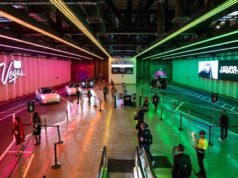Marketing is all about experiences now; to succeed it will need the two-letter technologies: AR, VR and A. I. And to scale it will need smartphones, selfies, live-streaming and social media.
In the 1989 comedy Back the Future, Part 2, Marty McFly travels into the high-tech, space-age future of 2015 where he encounters, among other dazzling wonders, a shark hologram advertising Jaws 10.
That kind of advertising is called experiential marketing, where consumers are deeply immersed in a brand in a way that’s novel, emotional and memorable.
Advertising on the web, TV, radio, print publications, billboards and elsewhere is here to stay. But it’s being supplemented and boosted by the rise of experiential marketing with the aid of powerful newly ubiquitous technology. Unlike more traditional forms of advertising, it appears at first as if experiential marketing doesn’t scale.
But it does.
Back to the Future deserves credit for predicting augmented reality experiential marketing, but it failed to predict the trend that makes it scale: smartphones, selfies, live-streaming and social media.
Marketers are content creators. But with experiential marketing, they’re experience creators, too — and consumers create and broadcast the content. (This is a good thing, because consumers find content created and shared on social media more influential than traditional forms of advertising.)
A recent study by the research from Freeman found that more than one in three CMOs expect to spend between 21% and 50% of budgets for experiential marketing.
Experiential marketing is popular, but expensive. And spending is exploding right now. But spending isn’t preparation.
The idea that experiential marketing will become a big part of the budget is uncontroversial. It’s definitely coming. The cost will be astronomical. And enterprises are woefully unprepared for it.
Here’s why: The most compelling brand experiences will happen via augmented reality (AR) , virtual reality (VR) and artificial intelligence (A. I.) .
Because experiential marketing events succeed only if they’re very new and surprising, these promotions will have to be developed frequently and rapidly.
Consider the «escape room, » a common experiential marketing approach. The idea is that whenever influencers are gathered in a boring place (trade show or airport) or find themselves at boring moments during an exciting event (sports event, concert) , brands can provide escapist, total-immersion experiences inside purpose-built rooms.
Such «escape rooms» dominated innovative marketing at Austin’s SXSW conference this year. Shows like Prison Break and Bates Motel constructed show sets where attendees could live in the shows for a few minutes (then, of course, take and post selfies of them inside) .
What’s inevitable is that the «escape room» concept will become a VR experience and move far beyond TV shows. Surprising consumers will become increasingly important and difficult, so «escape room» events will become a form of VR game development.
A variation of that model is that specific spaces will be populated by AR objects or games or information, and using either brand-supplied goggles or consumer-supplied ones, consumers will be able to see virtual branded objects placed in the real world (just like Marty McFly’s «Jaws 10» experience) .
AdAge magazine this month called AR » marketing’s trillion-dollar opportunity .»
In December, the entirety of Covent Gardens in London became an AR wonderland, as shoppers engaged in a treasure hunt in the mall’s 140 participating stores.
A bar in London called City Social recently introduced augmented reality to the bar experience. Using an app on their smartphones, customers could watch augmented reality characters dance and play music around drink coasters. This is a proof of concept, but imagine the opportunities for drink brands to advertise to bar patrons.
While event and location experiential marketing will become an exercise in AR app development, both VR and AR experiences will be made truly interactive only through great A. I. Experiential marketing campaigns will depend on A. I. bots with sophisticated interactivity and machine learning abilities.
Marketers are facing a future where they’ll have to do what is currently impossible: Rapid development of VR, AR and A. I.
Who’s going to do this?
For small- and medium-size businesses, the answer is obvious: They’ll hire experiential marketing specialists, and those agencies will have more developers and IT professionals than creatives.
For enterprises, the answer is less clear. The biggest companies will almost certainly outsource some experiential marketing campaigns, and do some of it in-house.
Another point to consider: Developers who specialize in VR game development, AR and A. I. will be in huge demand, and both agencies and enterprises will have to compete with Silicon Valley companies and everyone else for this expertise.
Even the job of CMO will change completely. CMOs will become hybrid CMO-CIO roles, as understanding the IT, security, development and other ramifications will be necessary for success, even when working with a specialist agency. Coordination between competing agencies, and with in-house IT, will be a crucial part of the job.
One major challenge in event marketing is mobility. And the challenge will be enormous.
In order to be effective, experiential marketing events need to both thrill the audience live in person, on site, but also enable that consumer or influencer to broadcast to social media either through «selfies, » the capturing and sharing of video or the live-streaming of video.
This has to be possible in arbitrary locations, often in places with unreliable wireless connectivity and electrical power.
«Virtual attendance» will become a massive part of experiential marketing, outpacing even actual attendance. Five years from now, a Beyoncé concert attended by 20,000 people will be experienced live in virtual reality by 500,000.
The ability to live-stream 4K, 360-degree video (experienced using VR headsets) in the middle of an open field at an outdoor concert will become as big a part of marketing as the simple sponsoring of concerts.
It gets worse.
Within 10 years, self-driving cars will go mainstream. And these cars won’t be like today’s cars. They’ll be living rooms on wheels, and the ultimate opportunity for immersive virtual reality-based marketing.
In fact, the branding opportunity for such a captive audience will be so great that brands will inevitably build custom-outfitted autonomous cars, then offer free rides to influencers at trade shows and other locations.






